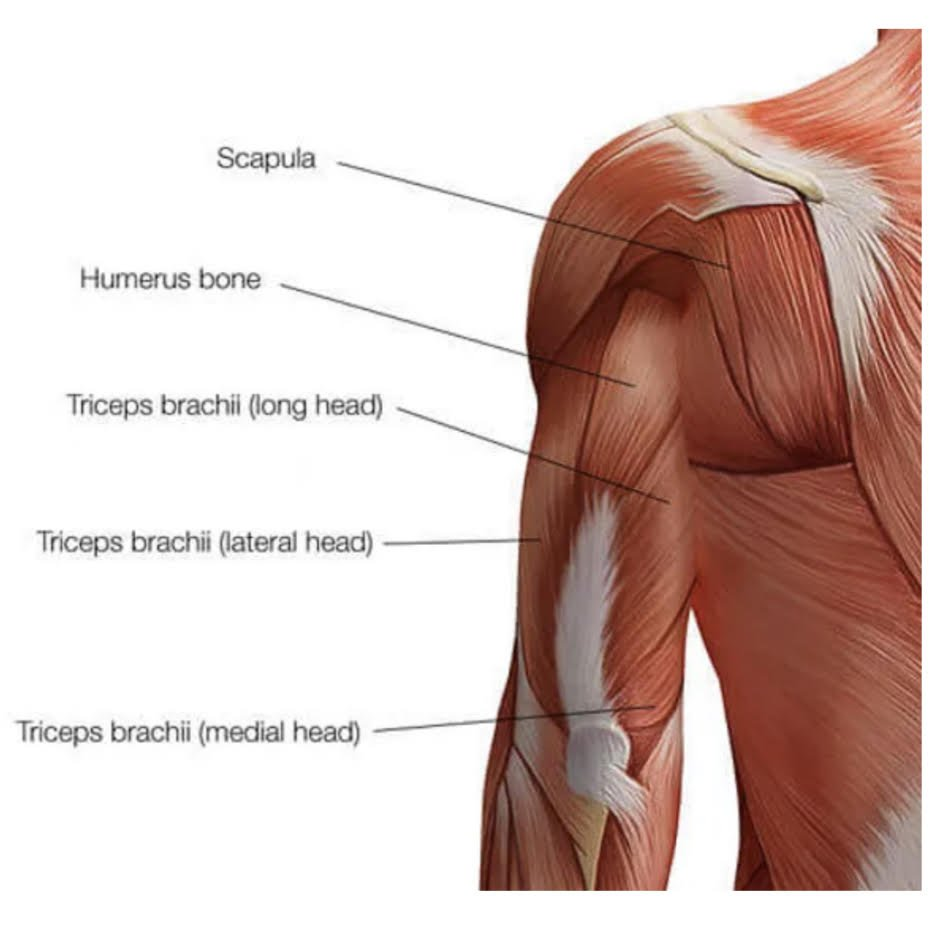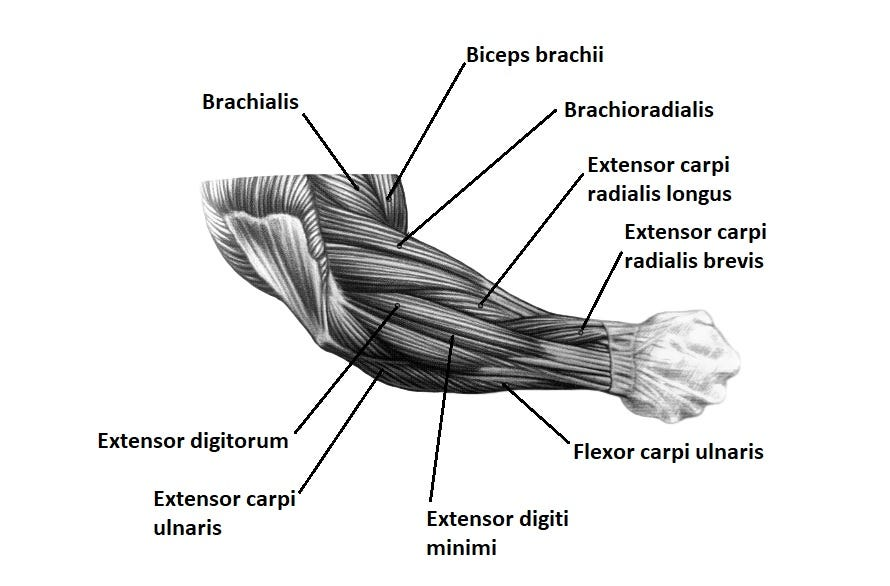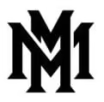Ultimate Arm Workout Guide: Build Bigger Biceps, Triceps, and Forearms
The biceps brachii is a two-headed muscle with distinct functional components: the short head and the long head. Each head has unique characteristics and training requirements, and this guide will detail how to effectively target both. Additionally, it includes information on advanced techniques, grip variations, and the importance of stretching to ensure maximum growth and strength.
Biceps Brachii
The “biceps” are located on the front of the arm, and is responsible for retracting the arm. The bicep is split into 2 parts. The short head and the long head.
Short Head of the Biceps
The short head has a high proportion of slow-twitch muscle fibers, which are endurance-oriented. It provides width to the biceps and can be activated more effectively when the elbow is positioned in front of the torso.
Isolation Techniques and Tips
- Elbow Positioning: Exercises where the elbow is kept in front of the body reduce long head involvement and emphasize the short head.
- Mind-Muscle Connection: Focusing on squeezing the biceps at the top of each repetition can increase short-head activation. Flexing the biceps between sets enhances blood flow and mind-muscle connection.

Exercises for the Short Head
- Concentration Curl: Eliminates momentum, isolates the biceps, and emphasizes the inner head.
- Tips: Use a slow, controlled motion, and hold for a moment at the top to maximize contraction.
- Preacher Curl: Keeps the elbows in a fixed, forward position, targeting the short head effectively.
- Variations: Experiment with an EZ bar for a more comfortable wrist position or try single-arm preacher curls for added isolation.
- High Cable Curl: With arms angled upward, this exercise puts emphasis on peak contraction, which recruits the short head significantly.
Best Training Methods
- Rep Range: Aim for 10-15 reps to take advantage of the short head’s endurance potential.
- Drop Sets: Start with a challenging weight, perform reps to failure, reduce the weight by 20-30%, and immediately continue. This technique fatigues the short head, promoting growth.
- Eccentric Focus: Control the lowering phase (eccentric) to increase time under tension, which stimulates growth.
- Partial Reps: After reaching failure on full reps, perform a few partial reps in the bottom half to fully fatigue the short head.
- Slow Negatives: Use a slow, 4-6 second eccentric phase on preacher curls to maximize muscle damage and hypertrophy.
Grips and Their Effects
- Wide Grip Barbell Curl: Shifts the load inward, placing more stress on the short head. This grip can help add width to the biceps.
- Neutral Twist Curl: Start with a neutral grip, twist to supinated as you curl up, which can enhance the inner biceps’ engagement through the entire range of motion.
Stretching and Safety
Exercises like preacher curls provide a stretch for the short head at the bottom. Avoid fully extending the elbows under heavy load to prevent strain on the tendons
Long Head of the Biceps
The long head is primarily composed of fast-twitch fibers, which are geared toward explosive power. The long head gives the biceps the “peak” and is especially noticeable from the back side of the arm. It plays a role in shoulder flexion, forearm supination, and elbow flexion. Some of the good exercises for the long head are incline dumbbell curls, standing supinated curls, and cable curls with a rope attachment.
Isolation Techniques
- Elbow Positioning: By positioning the elbow behind the torso (e.g., incline dumbbell curls), the long head is put under a stretch, increasing its recruitment.
- Grip Adjustments: A narrower grip on barbell curls can shift more emphasis to the long head, creating a taller biceps peak over time.
Exercises for the Long Head
- Incline Dumbbell Curl: By lying back on an incline bench, the long head is stretched and emphasized.
- Tips: Maintain a controlled motion and keep the shoulders down to avoid activating shoulder muscles.
- Dumbbell Drag Curl: Involves pulling the elbows back during the curl to shift emphasis onto the long head.
- Weighted Chin-Up (Supinated Grip): Targets the long head and allows for heavy loading with a bodyweight exercise.
- Variation: Use a slow eccentric to increase tension and further activate the long head.
Best Training Methods
- Rep Range: The long head responds well to heavier weights in the 6-10 rep range.
- Rest-Pause Sets: Perform a set to failure, rest 10-15 seconds, then continue with additional reps to push fast-twitch fibers to full activation.
- Mechanical Drop Sets: Begin with incline curls to isolate the long head, then switch to standing curls to finish as the long head fatigues.
Advanced Techniques
- Explosive Reps: Use an explosive concentric phase to recruit more fast-twitch fibers, particularly useful in low-rep sets.
- Partial Reps in the Stretch Position: Perform partials at the end of incline dumbbell curls to keep the long head under tension, focusing on the stretch
- Adjusting the tempo of each rep can optimize growth. For example, using a slow eccentric phase maximizes time under tension, especially effective for hypertrophy.
Grips and Their Effects
- Close Grip Barbell Curl: Emphasizes the outer biceps, which helps create a defined peak. A close grip keeps tension on the long head.
- Reverse Grip Curl: While primarily targeting the forearms, this variation can help strengthen supporting muscles for biceps development.
Stretching and Safety
- Fully extending the arm at the bottom of incline curls places a stretch on the long head. Be mindful of shoulder and biceps tendon strain when working in the stretched position.
Brachialis
The brachialis is a major muscle in the upper arm that lies beneath the biceps brachii. It is primarily responsible for flexing the elbow joint.
Adjusting the tempo of each rep can optimize growth. For example, using a slow eccentric phase maximizes time under tension, especially effective for hypertrophy.
Isolation Techniques for the Brachialis
Isolating the brachialis involves minimizing biceps involvement by altering grip and positioning. Here’s how to target the brachialis effectively:
Grip Selection:
- Pronated (Overhand) Grip: This grip takes the biceps out of the equation, making the brachialis the primary mover.
- Neutral (Hammer) Grip: The neutral position also emphasizes the brachialis, though it still allows some biceps recruitment.
Elbow and Body Positioning:
- Arms in Line with the Torso: Keeping elbows close to the body and in line with the torso helps isolate the brachialis, especially when combined with a pronated or neutral grip.
Effective Exercises to Target the Brachialis
Hammer Curl
- Description: With a neutral grip, hammer curls activate the brachialis more than traditional curls.
- Execution: Hold dumbbells with a neutral grip and curl with your elbows tucked close to the body. Lift until your forearms are vertical, then slowly lower.
- Variation: Cross-body hammer curls shift emphasis slightly, recruiting more brachialis muscle fibers.
2. Reverse Curl
- Description: Using a pronated grip shifts the primary load from the biceps to the brachialis.
- Execution: Use an EZ bar or barbell and keep wrists aligned with your forearms to avoid strain. Curl up until your elbows are fully flexed, then lower slowly.
- Tips: Use moderate weights with high reps (10-15) for optimal stimulation without risking joint strain.
3. Zottman Curl
- Description: A hybrid curl that combines a supinated curl up and a pronated curl down, engaging the brachialis extensively.
- Execution: Start with a supinated curl to bring the dumbbell up, then rotate to a pronated grip at the top and lower slowly. This eccentric pronation is excellent for targeting the brachialis.
- Benefits: Both eccentric loading and pronation engage the brachialis for hypertrophy and strength gains.
4. Cable Rope Hammer Curl
- Description: Using cables allows constant tension on the brachialis throughout the movement.
- Execution: Attach a rope to a low cable and perform a hammer curl, pulling the rope to shoulder height.
- Advantages: Continuous resistance from the cable helps fatigue the brachialis more effectively than free weights alone.
coracobrachialis muscle
The coracobrachialis is a small, slender muscle located in the upper arm. It plays an important role in the movement and stabilization of the shoulder joint. The coracobrachialis is associated with the biceps brachii and brachialis muscles. It lies medial to the short head of the biceps brachii.
Due to its role in shoulder movements, the coracobrachialis can become tight or strained, particularly in athletes or individuals who perform repetitive overhead activities.
Since the musculocutaneous nerve pierces this muscle, tightness or hypertrophy of the coracobrachialis can sometimes compress the nerve, leading to pain or weakness in the arm.
Triceps Brachii
The “triceps” are located on the back of the arm and are responsible for extending the arm. The triceps are separated into 3 parts. The long head, lateral head, and medial head.
The triceps has a balanced composition of fast- and slow-twitch muscle fibers, with a slight emphasis on fast-twitch fibers. This composition allows for effective growth from a mix of heavy, low-rep work and higher-rep endurance training.
Long Head
The long head extends the elbow joint, and helps with the extension of the arm at the shoulder joint. Some exercises to isolate the long head are overhead tricep extensions with a cable or dumbbell, skullcrushers, rope pushdowns, and bodyweight dips.
Because the long head crosses the shoulder joint, exercises that place the arm overhead will put the long head in a stretch and increase activation.
- Overhead Exercises: Include overhead triceps extensions and French presses to emphasize the long head.
- Body Positioning: Try keeping your elbows slightly behind your head for an added stretch.
Lateral Head
The lateral head is primarily responsible for extending the elbow joint, but also helps with forearm extension. some exercises that are going to grow your lateral head are going to be close grip bench press, diamond pushups, weighted dips, and kickbacks.
The lateral head is most active when the elbow is in a more neutral or slightly pronated position, such as with exercises using a cable or a close grip.
- Cable and Pronated Grip Exercises: Movements like rope pushdowns and close-grip bench presses engage the lateral head.
- Elbow Position: Maintain elbows close to your body to emphasize this head.

Medial Head
The medial head is smaller and assists the lateral head in extending the elbow and is better for more precise movements. Training the medial head adds more mass to the upper portion of the arm. The exercises you see people doing to train their medial head are reverse grip pushdowns, weighted dips, and cable kickbacks.
Although it’s difficult to isolate, the medial head gets recruited when you’re using heavier weights or near the lockout phase of an extension.
- Heavy Compound Movements: Exercises like close-grip bench presses and dips target the medial head effectively.
- Shortened ROM Movements: Movements with shorter range of motion and higher weight, such as partial lockouts, also activate the medial head.
Grip Variations and Their Impact on Triceps Activation
Different grips and elbow positions can shift emphasis across the triceps heads.
- Neutral Grip (Hammer): Maximizes involvement of the lateral head.
- Underhand (Supinated) Grip: Works well on cable pushdowns, shifting some activation to the lateral head while ensuring stable elbow position.
- Wide vs. Close Grip: Close grip (as in close-grip bench press) focuses on all heads equally, while wide grip generally increases chest involvement but can help diversify elbow angles.
Example Triceps Workout
Close-Grip Bench Press – 4 sets of 6-8 reps
- Heavy load, full range of motion for overall strength and growth.
Overhead Dumbbell Extension – 3 sets of 8-12 reps
- Targets the long head, ensuring a full stretch and contraction.
Rope Pushdown – 4 sets of 10-15 reps (with drop set on final set)
- Emphasizes lateral and medial heads with a squeeze at the bottom.
Skull Crushers – 3 sets of 8-10 reps
- Prioritizes the long head and provides a great stretch.
Bodyweight Dips – 2 sets to failure
- Finisher for all-around triceps burnout.
Finisher: Isometric Hold
Hold the position of a partial triceps extension (as if halfway through a skull crusher) for 20-30 seconds to burn out remaining energy in the triceps.
Forearms
Brachioradialis
The brachioradialis is a muscle in the forearm that plays a huge role in elbow flexion
It helps return the forearm to a neutral position from either a pronated (palm down) or supinated (palm up) position.
The brachioradialis is unique in its ability to function effectively regardless of the forearm’s position. It is most effective when the forearm is in a neutral position.
It is heavily involved in various daily activities that require gripping, lifting, and rotating the forearm.

Flexor Carpi Ulnaris
- Flexes and adducts the wrist
- Doing wrist curls with a dumbbell can be used to strengthen the FCU
Flexor Carpi Radialis
- Extends and adducts the wrist
- Reverse wrist curls are used to strengthen the FCR
Extensor Carpi Ulnaris
- Extends and adducts the wrist
- Reverse wrist curls are used to strengthen the ECU
Extensor Carpi Radialis Longus and Brevis
- Both muscles extend and abduct the wrist
- Doing an exercise called the “wrist roller” will train these muscles effectively
Smaller Muscles & Stabalizers
Pronator Teres
- Pronates the forearm, turning the palm downward
- Extend your arm in front of you with the palm facing upward. Use your other hand to gently pull your fingers back towards you, stretching the forearm muscles.
Supinator
- Supinates the forearm, turning the palm upward.
- Extend your arm in front of you with the palm facing downward. Use your other hand to gently pull your fingers back towards you, stretching the forearm muscles
Why it's so important
When taking risk for injury into consideration it’s always smart to train every muscle, including the stabilizers. Your arms for example are higher risk of injury when using heavier weight. In order to prevent a bicep tear, it’s important to build good stretching habits. Stretch before you exercise, and stretch at the bottom portion of every exercise as well. Doing isometrics are also important for isolating certain stabilizer muscles that don’t get the attention they deserve.
Factors That Make a Difference
- When doing exercises that isolate the triceps or biceps it is best to switch up your grip every couple times you do your exercises. By keeping your elbows tucked and a supinated grip you get better medial head activation in pushdowns, but when you switch your grip up you target more of your lateral head.
- Focus on mind muscle connection
- Keep proper form
- A balanced nutrition keeps you from crashing mid workout, allowing for more energy
- Progressive overload helps get through a plateau
- Adequate rest and recovery to prevent injury, and maximize muscle gain.
- Proper hydration is key
- Setting realistic goals means lifting realistic weight with proper form
- Have fun!
- Never Give Up On Yourself!
Comprehensive Arm Workout
Barbell Curls
- Stand with your feet shoulder-width apart, holding a barbell with an underhand grip.
- Curl the barbell up to shoulder height, keeping your elbows close to your body.
- Lower the barbell back to the starting position.
- Perform 3 sets of 10-12 reps.
Hammer Curls
- Stand with your feet shoulder-width apart, holding a dumbbell in each hand with a neutral grip (palms facing each other).
- Curl the dumbbells up, keeping your elbows close to your body.
- Lower the dumbbells back to the starting position.
- Perform 3 sets of 10-12 reps.
Concentration Curls
- Sit on a bench with your legs spread apart, holding a dumbbell in one hand.
- Rest your elbow on the inside of your thigh and curl the dumbbell up to shoulder height.
- Lower the dumbbell back to the starting position.
- Perform 3 sets of 10-12 reps per arm.
Close-Grip Bench Press
- Lie on a bench and hold a barbell with a shoulder-width grip.
- Lower the barbell to your chest, keeping your elbows close to your body
- Press the barbell back to the starting position.
- Perform 3 sets of 10-12 reps.
Tricep Dips
- Position yourself on parallel bars or the edge of a bench.
- Lower your body until your upper arms are parallel to the floor.
- Press back up to the starting position.
- Perform 3 sets of 10-12 reps.
Overhead Tricep Extension
- Stand with your feet shoulder-width apart, holding a dumbbell with both hands overhead.
- Lower the dumbbell behind your head, keeping your elbows close to your ears.
- Extend your arms back to the starting position.
- Perform 3 sets of 10-12 reps.
Wrist Curls / Reverse Wrist Curls
- Sit on a bench and rest your forearms on your thighs, holding a dumbbell in each hand with an underhand or overhand grip.
- Curl your wrists upward.
- Lower the dumbbells back to the starting position.
- Perform 3 sets of 15-20 reps.
Farmer's Walk
- Stand with your feet shoulder-width apart, holding a heavy dumbbell in each hand.
- Walk forward for a set distance or time, keeping your core engaged and your shoulders back.
- Perform 3 sets of 1-2 minutes
Supination and Pronation with Dumbbell
- Sit on a bench with your forearm resting on your thigh, holding a dumbbell vertically with your thumb on top.
- Rotate your forearm to turn your palm upward (supination)
- Rotate your forearm to turn your palm downward (pronation).
- Perform 3 sets of 12-15 reps for each direction.

